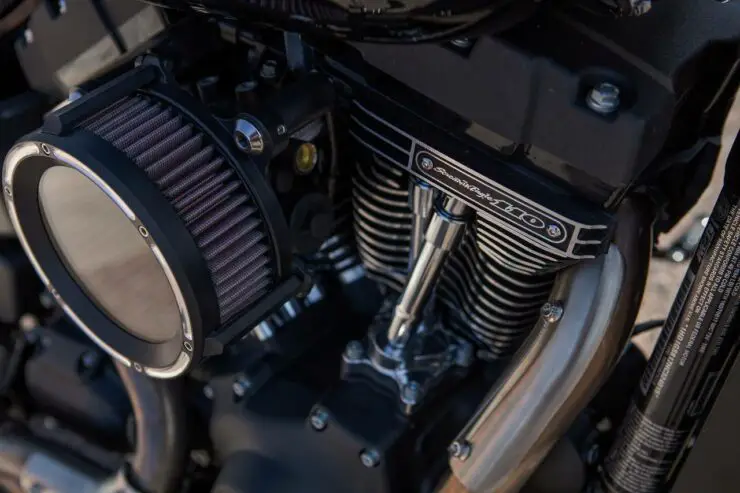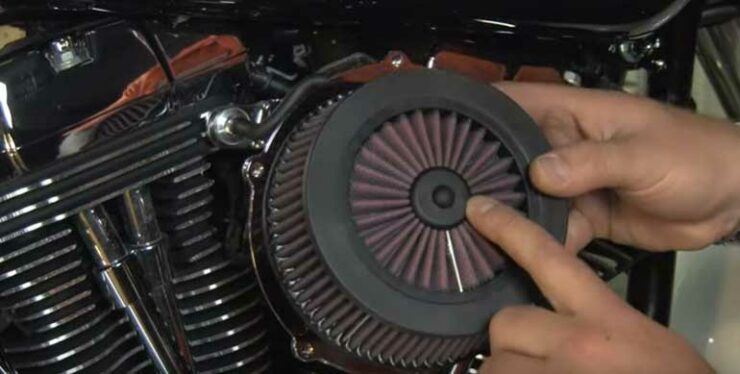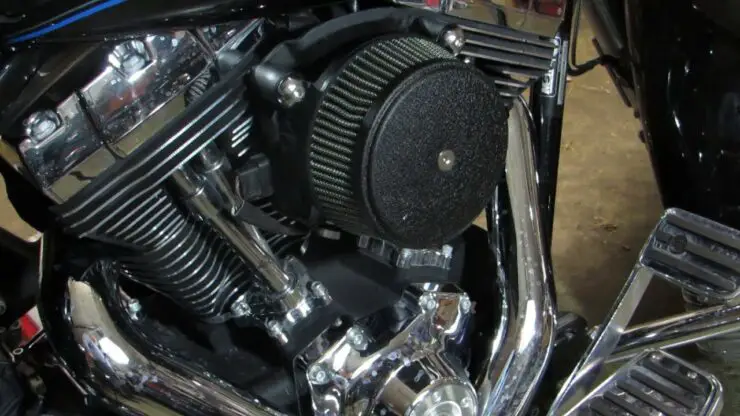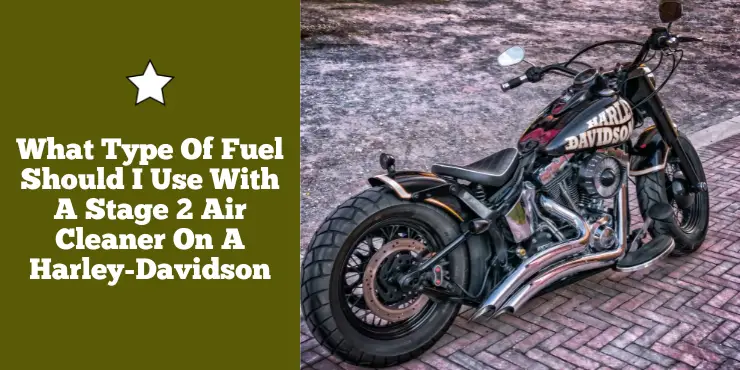Are you the proud owner of a Harley-Davidson motorcycle? Do you want to improve your bike’s performance with a Stage 2 air cleaner? Are you wondering what type of fuel to use with this air cleaner?
For a Harley-Davidson with a Stage 2 air cleaner, use premium fuel with a high octane rating (91 or above) to prevent engine knocking and ensure optimal performance.
In this article, we will discuss all the details you need to know to get the best performance out of your Harley-Davidson with a Stage 2 air cleaner. We’ll cover details such as the types of fuel available, the best type of fuel to use, and other important considerations. So, read on to discover the answers to all of your questions about fuel and a Stage 2 air cleaner for a Harley-Davidson.
How does a Stage 2 Air Cleaner work?
Harley-Davidson bikes are known for their iconic designs and powerful engines. One of the components that contribute to the performance of these bikes is the air cleaner system. In recent years, Stage 2 Air Cleaners have gained a lot of popularity among Harley-Davidson enthusiasts. This modification offers improved airflow and enhanced engine performance among other benefits.
Stage 2 Air Cleaners, often referred to as high-flow air cleaners, are aftermarket components designed to replace the stock air intake systems on Harley-Davidson bikes. They’re an integral part of the Stage 2 Performance Upgrade, which aims to optimize the bike’s air and fuel delivery for improved horsepower and torque.
The primary function of a Stage 2 Air Cleaner is to improve the airflow into the engine. Stock air cleaners are designed to meet emission regulations and noise restrictions, which can often limit the amount of air the engine can breathe. Meanwhile, Stage 2 Air Cleaners feature larger filter elements and less restrictive housing, allowing for increased airflow.
Despite the focus on enhanced airflow, Stage 2 Air Cleaners don’t compromise on filtration. They make use of high-quality filter materials that efficiently trap dust, dirt, and debris while allowing a higher volume of clean air to pass through. This balance between airflow and filtration is important for engine longevity and performance.
These air cleaners can often be paired with other performance upgrades like aftermarket exhaust systems and engine tuning. This combination is designed for creating a balanced air-to-fuel ratio, ensuring that the engine receives the right amount of oxygen for combustion. As a result, the motorcycle experiences an increase in torque and horsepower, especially in the mid to high RPM range.
To optimize the performance gains from a Stage 2 Air Cleaner, many riders choose to opt for dyno tuning. This process involves adjusting the fuel injection mapping and ignite ion timing to ensure the engine runs efficiently with the increased airflow. Dyno tuning can greatly maximize the potential power gains and improve throttle response.
What are the benefits of using a Stage 2 Air Cleaner?
Riders looking to unlock the true potential of their Harley-Davidson bikes often turn to aftermarket upgrades. One of the most popular modifications is the Stage 2 Air Cleaner. It comes with a plethora of benefits that take your riding experience to another level. Here are some of the benefits of using a Stage 2 Air Cleaner.
Better airflow for improved performance
One of the biggest benefits of Stage 2 Air Cleaners is the significant improvement in airflow to the engine. The stock air intake system on a Harley-Davidson bike is designed with conservative specifications to meet emission regulations and sound restrictions. A Stage 2 Air Cleaner will provide less restrictive airflow, allowing the engine to breathe more freely. This will result in a notable increase in horsepower and torque.

Optimized air-to-fuel ratio
When paired with other Stage 2 upgrades like the aftermarket exhaust system and engine tuning, the Stage 2 Air Cleaner will help create a balanced air-to-fuel ratio. This will ensure that the engine receives the right amount of oxygen for combustion. The final result is improved fuel efficiency and throttle response, contributing to a smoother and more enjoyable riding experience.
Improved filtration without sacrificing airflow
Despite the focus on increased airflow, Stage 2 Air Cleaners don’t compromise on filtration. They come equipped with high-quality air filter elements that efficiently trap dust, dirt, and debris while still allowing a higher volume of clean air to pass through. This helps in maintaining the longevity and reliability of the engine.
Reduced engine strain and heat build-up
With better airflow, the engine doesn’t need to work as hard to draw in air. This reduces the strain on engine components, leading to less heat build-up and improved overall engine performance. Moreover, it also contributes to the longevity of critical engine parts.
Customization and aesthetic appeal
Stage 2 Air Cleaners come in a wide range of designs, allowing bikers to personalize the look of their motorcycles. They can be chosen to complement the overall aesthetics of the bike, adding a unique touch to its appearance.
Increased resale value
Upgrading a Harley-Davidson bike with Stage 2 upgrades can potentially increase its resale value. Riders who appreciate the benefits of enhanced performance might be willing to pay a premium for a well-maintained and upgraded bike.
Easy installation
Stage 2 Air Cleaners are designed to be compatible with a variety of Harley-Davidson models and many aftermarket manufacturers offer air cleaner kits with the necessary components. This makes the installation process rather straightforward, allowing riders to enjoy the benefits of the upgrade without extensive mechanical expertise.
What type of fuel should I use with a Stage 2 Air Cleaner on a Harley-Davidson?
Harley-Davidson bikes feature extremely powerful engines capable of delivering thrilling and comfortable rides. However, riders are always looking for more power and powerful rides. A modification like Stage 2 Air Cleaner can go a long way in improving your performance levels. However, for riders considering Stage 2 upgrades, choosing the right type of fuel is important. This might make you wonder what type of fuel should I use with a Stage 2 Air Cleaner on a Harley-Davidson bike.
Ideally, it is important to use premium unleaded gasoline with a minimum octane rating of 91 as it’ll help reduce engine knocking and pinging while maintaining optimal performance. However, there are other options as well. Here are the different types of fuel you can use with a Stage 2 Air Cleaner in your Harley-Davidson bike –

Regular pump gasoline
Regular pump gasoline, typically referred to as “E0” (containing no ethanol) is the traditional and most widely used fuel option available for Harley-Davidson motorcycles. It is a refined product primarily derived from crude oil and contains only trace amounts of ethanol.
E0 gasoline is known for its stability and consistent composition. It ensures that the fuel remains stable in your bike’s tank, reducing the risk of phase separation and other ethanol-related issues. It typically has a higher energy compared to ethanol-blended fuels. This can translate to slightly better fuel efficiency and power delivery. It is readily available at most gas stations across the USA, making it convenient for riders.
Traditional gasoline is derived from fossil fuels, making it less environmentally friendly compared to other options.
Ethanol-blended gasoline
Ethanol-blended gasoline, commonly referred to as “E10” (containing up to 10% ethanol) is a blend of gasoline and ethanol, a biofuel desired from renewable sources like corn or sugarcane. Ethanol-blended gasoline has become increasingly popular because of its reduced environmental impact and potential performance benefits.
Ethanol-blended gasoline produces fewer harmful emissions, which contributes to lower carbon dioxide (CO2) levels and reduced air pollution. It typically has a higher octane rating compared to regular gasoline. This can result in improved engine performance and reduced knocking for pinging. Ethanol is derived from renewable crops, which makes it a more sustainable and eco-friendly fuel option.
Ethanol contains less energy per gallon compared to gasoline, which can result in slightly lower fuel efficiency and power output. Moreover, it has downsides like the potential to attract moisture, leading to phase separation, and causing issues in fuel systems if left untreated for extended periods.
High octane gasoline
High octane gasoline, often referred to as “premium” gasoline, is a refined fuel with an octane rating that is higher than standard pump gasoline. The higher octane rating indicates the fuel’s resistance to knocking or pre-ignition, making it suitable for high-performance engines.
High octane gasoline minimizes the risk of knocking or pinging in the engine, which can be important for high-performance applications. The increased octane rating can enhance engine performance, providing smoother power delivery and improved throttle response.
This type of fuel also produces fewer carbon deposits in the engine, contributing to cleaner combustion and potentially extending the engine’s life.
High octane gasoline is typically more expensive than regular pump gasoline, which can increase the cost of fueling your bike While high octane gasoline is readily available at several gas stations, it might not be as universally accessible as regular gasoline.
Race fuel
Race fuel is a specialized type of fuel engineered for high-performance racing applications. It is typically available in various octane levels, often well above 100 octane, making it ideal for extreme performance needs.
Race fuel is designed to extract the maximum potential from high-performance engines, delivering exceptional horsepower and torque gains. It comes in various octane levels, which allows riders to choose a specific grade tailored to their bike’s performance needs. Moreover, it is formulated for consistency, reducing variations that can occur with pump gasoline.
Race fuel is considerably more expensive than both regular pump gasoline and high octane gasoline, making it a rather expensive option for riders. Further, it is primarily sold at specialty racing supply stores or tracks, limiting accessibility for everyday riders.
Factors to consider when choosing the right fuel for Stage 2 Air Cleaners
When it comes to enhancing the performance of your Harley-Davidson motorcycle with a Stage 2 Air Cleaner, choosing the right type of fuel is important. This is why you will want all the help you can get in deciding the best fuel option for your modification. There are a number of factors that play a significant role in determining which type of fuel will best complement the Stage 2 Air Cleaner of your Harley-Davidson bike. Here are some of the factors that you must consider as they will help you make a well-informed decision.
#1. Availability
Availability of the chosen fuel type will be an important factor to consider, especially for riders who use their Harley-Davidson motorcycles for daily commuting or long-distance travel. Fuel availability can vary depending on your location.
Regular pump gasoline is widely accessible at virtually all gas stations around the United States. This type of fuel is quite easy to find, making it a convenient option for most riders.
Ethanol-blended gasoline is also commonly available in many regions, especially in the United States. While readily available, it is important to be aware of potential issues related to ethanol content like phase separation.
High octane gasoline is available at most gas stations but it might be less common than regular gasoline. Riders might have to plan routes around gas stations that offer high octane options.
Race fuel is primarily sold at specialty racing supply stores, tracks, and some select gas stations. It isn’t as widely available as other fuel types and riders might have to travel to specific locations for it.
Cost
Moreover, you should also consider your budget when choosing fuel. The cost of fuel is an important consideration for riders as it directly impacts the overall expenses associated with operating a Harley-Davidson bike.
Regular pump gasoline is generally the most budget-friendly option, making it accessible to a wide range of riders. Meanwhile, Ethanol-blended gasoline is comparable to or slightly cheaper than regular pump gasoline.
High octane gasoline is typically more expensive than regular pump gasoline, representing a moderate increase in overall fuel expenses. Race fuel is significantly more expensive than other fuel types, making it the most expensive option.
Performance
Performance is another critical consideration for riders looking to maximize the benefits of Stage 2 upgrades and improve the overall riding experience.
Regular pump gasoline offers satisfactory performance for most riders, especially those who aren’t seeking extreme power gains. Ethanol-blended gasoline offers a good balance between performance and cost, making it a popular option for many riders.
High octane gasoline enhances engine performance, especially in high-compression or high-performance applications. Race fuel offers maximum performance gains, making it ideal for riders who are focused on achieving the highest power output.
Octane rating
The octane rating is another important factor when selecting fuel for your Stage 2-equipped Harley-Davidson bike. Higher octane fuels tend to have better resistance to engine knock, which can be especially important for motorcycles with performance upgrades like Stage 2 Air Cleaners.
Regular pump gasoline (87 to 91 octane) is suitable for most Harley-Davidson models. It offers amazing performance without excessive cost.
High octane gasoline (91 or higher octane) is ideal for motorcycles with high-compression engines. It can deliver improved performance and reduced knocking.
Race fuel (100 or higher octane) is reserved for extreme-performance applications. It offers maximum power but comes at a premium cost.
Ethanol content
Some fuels, especially in the United States, contain ethanol up to 10%. While ethanol-blended gasoline is widely available and can be compatible with Stage 2 upgrades, it is important to consider its impact.
Ethanol can raise the octane rating and potentially improve engine efficiency. Ethanol can attract moisture, potentially resulting in phase separation in fuel systems if left untreated for extended periods. Check your motorcycle’s compatibility and consider using a fuel stabilizer if using E10.

Tips for maintenance of Stage 2 Air Cleaners in Harley-Davidson bikes
When you install a Stage 2 Air Cleaner to enhance your motorcycle’s performance, proper maintenance will be important. Proper maintenance will not only help increase the longevity of the air cleaner but also ensure optimal functionality. Here are some of the maintenance tips you must consider for maintaining the Stage 2 Air Cleaner in your Harley-Davidson bike.
#1. Regular inspection
Regular visual inspections are the first line of defense in air cleaner maintenance. You should make it a habit to check your Stage 2 Air Cleaner for any visible signs of damage, loose components, or debris buildup. Inspect the filter element for dirt, dust, and foreign particles.
#2. Clean at the recommended frequency
The cleaning frequency of your Stage 2 Air Cleaner will depend on various factors, including your environment and riding conditions. As a general guideline, you should check and clean the air cleaner at least once every 5,000 miles or as recommended by the manufacturer. In dusty or off-road riding conditions, more frequent cleaning might be needed.
#3. Use appropriate cleaning products
When cleaning the air cleaner element, make use of a cleaner specifically designed for air filters. Avoid using harsh chemicals or solvents as they can damage the filter material and compromise its effectiveness. Follow the manufacturer’s recommendations for cleaning products.
#4. Cleaning process
You must follow the right steps for cleaning the Stage 2 Air Cleaner on your bike. Here are the steps you must follow –
- Remove the air cleaner cover and filter element as per your bike’s manual
- Gently tap the filter element for dislodging loose debris and dirt
- Make use of a soft-bristle brush or compressed air for removing finer particles
- Soak the filter element in a suitable air filter element as per the manufacturer’s instructions
- Rinse the filter element thoroughly with water and allow it to dry completely
- Reassemble the air cleaner, ensuring that all components are secure
#5. Replace the filter on time
While cleaning the filter element is a routine task, eventually, it will reach a point where replacement is necessary. Always follow the manufacturer’s recommendations for filter replacement intervals. A worn-out filter can negatively impact your motorcycle’s performance.
#6. Sealing and tightening
When reassembling the air cleaner, make sure that all seals and gaskets are in good condition. Tighten all bolts and clamps securely to prevent air leaks, which can lead to reduced engine performance.
#7. Rain and moisture protection
Harley-Davidson bikes are built to withstand various weather conditions but it is still essential to protect your air cleaner from excessive moisture. If you anticipate riding in heavy rain or wet conditions, you should consider using a rain sock or air cleaner cover to prevent water from entering the filter.
#8. Professional maintenance
For complex Stage 2 Air Cleaner systems and advanced performance upgrades, you should consider seeking professional maintenance or tuning services. An experienced mechanic will make sure that your air cleaner is properly tuned to match your motorcycle’s performance modifications.
#9. Tune-ups and dyno testing
Regularly scheduled tune-ups and dyno testing can help optimize your motorcycle’s performance with Stage 2 Air Cleaners. A professional tune-up can help fine-tune your air-fuel mixture, ignition timing, and other factors for maximizing power output.
FAQs
What type of fuel should I use with a stage 2 air cleaner on a Harley-Davidson?
When using a stage 2 air cleaner on a Harley-Davidson, it’s important to use premium unleaded gasoline with a minimum octane rating of 91. This type of fuel helps to reduce engine knocking and pinging, as well as maintain optimal performance.
What are the benefits of using premium unleaded gasoline with a stage 2 air cleaner?
Using premium unleaded gasoline with a stage 2 air cleaner helps to improve engine performance, reduce engine knocking and pinging, and maintain optimal fuel efficiency. It also helps to reduce emissions, making it better for the environment.
What are the drawbacks of using lower octane fuel with a stage 2 air cleaner?
Using lower octane fuel with a stage 2 air cleaner can lead to reduced engine performance, increased engine knocking and pinging, and higher emissions. It can also lead to decreased fuel efficiency, increased wear and tear on the engine, and damage to the air cleaner. It is important to use the recommended fuel type and octane rating to ensure optimal performance and to avoid damage to the engine.
>>> Read more about Stage 2 Air Cleaner for Harley-Davidson <<<

